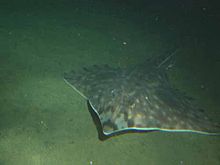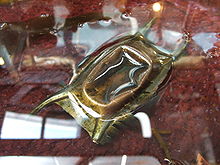- Big skate
-
Big skate 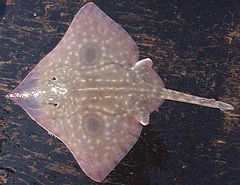
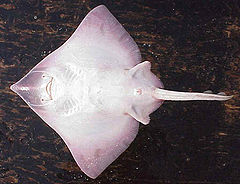
Conservation status Scientific classification Kingdom: Animalia Phylum: Chordata Class: Chondrichthyes Subclass: Elasmobranchii Order: Rajiformes Family: Rajidae Genus: Raja Species: R. binoculata Binomial name Raja binoculata
Girard, 1855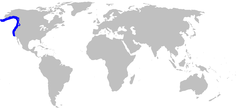
Range of the big skate Synonyms Raja cooperi Girard, 1858
The big skate (Raja binoculata) is the largest species of skate, family Rajidae, in the waters off North America. They are found along the Pacific coast from Alaska to Baja California, typically from the intertidal zone to a depth of 120 m (390 ft), and feed on benthic invertebrates and small fishes. They are unusual among skates in that their egg cases may contain up to seven eggs each. This species is one of the most commercially important skates off California and is sold for food.[2]
This species was described by Charles Frédéric Girard in 1855; its specific epithet binoculata is derived from the Latin bi meaning "two", and oculatus meaning "eyed", referring to the two prominent eyespots on its wings. Girard also described what would later be determined to be a junior synonym of R. binoculata, R. cooperi, based on notes made by James G. Cooper on a decaying big skate found ashore near the entrance of Shoalwater Bay, Washington.[3] In some older literature this species is placed in the genus Dipturus.[4]
Contents
Distribution and habitat
The big skate is found in the northeastern Pacific Ocean, from the eastern Bering Sea and the Aleutian Islands, as far south as Cedros Island off central Baja California. It is rare south of Point Conception, California. It occurs in coastal bays, estuaries, and over the continental shelf, usually on sandy or muddy bottoms but occasionally on low strands of kelp. Though reported to a depth of 800 m (2,600 ft), it is usually found no deeper than 120 m (390 ft). It frequents progressively shallower water in the northern parts of its range.[2][3] This species is abundant off British Columbia, where it prefers a depth of 26–33 meters (85–108 ft) and a temperature of 7.6–9.4 °C (46–49 °F).[5]
Description
The maximum known length of a big skate is 2.4 m (7.9 ft), though this species usually does not exceed 1.8 m (5.9 ft) and 91 kg (200 lb). This species has a flattened, diamond-shaped pectoral fin disk slightly wider than it is long, with a long, moderately pointed snout. The eyes are small and placed just ahead of the large spiracles. The teeth are small with raised cusps, numbering 24-48 rows in the upper jaw and 22-45 in the lower. There are two small dorsal fins on the tail, the anal fin is absent, and the caudal fin is reduced to a simple fold. There is a weak notch in each pelvic fin.[2][3]
Juveniles have smooth skin, while adults have small prickles on the dorsal surface and the underside on the snout, between the gill slits, and on the abdominal region. There are 2-3 thorns on the middle of the back, a row of 12-55 (usually 13-17) thorns along the midline of the tail, and an interdorsal thorn. Some older individuals have a thorn above each eye. The back is colored a mottled brown to reddish brown, olive-brown, or gray, with rosettes of small white spots or scattered dark blotches. There are two large dark spots with pale borders, one on each wing. The ventral side is white, sometimes with dark spots or blotches.[2][3]
Biology and ecology
Big skates are usually seen buried in sediment with only their eyes showing. They feed on polychaete worms, molluscs, crustaceans, and small benthic fishes. Polychaetes and molluscs comprise a slightly greater percentage of the diet of younger individuals. A known predator of big skates is the broadnose sevengill shark (Notorhynchus cepedianus); the eyespots on the skates' wings are believed to serve as decoys to confuse predators. Juvenile northern elephant seals (Mirounga angustirostris) are known to consume the egg cases of the big skate. Known parasites of the big skate include the copepod Lepeophtheirus cuneifer.[2][3]
This species is oviparous, and is one of the few skate species that typically have more than one embryo within each egg capsule, commonly called "mermaid's purses" when they are found washed up on beaches. The egg capsule of a big skate is the largest of any skate, measuring 23–31 cm (9–12 in) long and 11–19 cm (4–7 in) wide. Each capsule is oblong in shape and has a highly arched dorsal surface, nearly flat ventral surface, and parallel lateral edges that become somewhat concave towards the center of the case. At the corners of the case, there are four blunt, broad horns with the posterior pair being slightly longer. A single egg capsule may contain 1-7 (usually 3-4) eggs.[3]
The female deposits her eggs in pairs on sandy or muddy flats; there is no discrete breeding season and egg-laying occurs year-round.[3] Females may utilize discrete spawning beds, as large numbers of egg cases have been found in certain localized areas.[5] The young emerge after 9 months and measure 18–23 cm (7–9 in). Female big skates mature at 1.3–1.4 m (4 ft 3 in–4 ft 7 in) long and 12–13 years old, while males mature at 0.9–1.1 m (2 ft 10 in–3 ft 7 in) long and 7–8 years old.[2] The growth rate of big skates in the Gulf of Alaska are comparable to those off California, but differ from those off British Columbia. The lifespans of big skates off Alaska are up to 15 years, while those off British Columbia are up to 26 years.[6][7]
Relationship to humans
The big skate is frequently caught by recreational anglers, who usually release or discard them. It adapts well to captivity and is often displayed in public aquaria. This species is one of the three most important skates fished off the coast of California, though compared to other commercial fisheries it is of only minor importance. This species is usually taken as bycatch in bottom trawls; the pectoral fins are sold as "skate wings" and are eaten baked or fried. In the 1990s, the market value of skate wings rose to $0.40-$1.00 USD per pound, and catches of the big skate off California increased tenfold as the trawl fishery began marketing its skate and ray bycatch.[2] In 2003, a targeted fishery for the big skate and the longnose skate (Raja rhina) commenced in the Gulf of Alaska.[6] Population data following this increased exploitation is lacking, but the big skate's slow reproductive rate has led it to be assessed as Near Threatened by the World Conservation Union.[1]
References
- ^ a b Ellis, J. and Dulvy, N. (2000). Raja binoculata. In: IUCN 2008. IUCN Red List of Threatened Species. Downloaded on March 7, 2009.
- ^ a b c d e f g Bester, C. Biological Profiles: Big Skate. Florida Museum of Natural History Ichthyology Department. Retrieved on March 7, 2009.
- ^ a b c d e f g Ebert, D.A. (2003). Sharks, Rays, and Chimaeras of California. London: University of California Press. ISBN 0520234847.
- ^ Froese, Rainer, and Daniel Pauly, eds. (2009). "Raja binoculata" in FishBase. March 2009 version.
- ^ a b IUCN/SSC Shark Specialist Group (2005). Sharks, Rays and Chimaeras: The Status of the Chondrichthyan Fishes. IUCN. ISBN 2831707005.
- ^ a b Gburski, C.M., Gaichas, S.K. and Kimura, D.K. (October 2007). "Age and growth of big skate (Raja binoculata) and longnose skate (R. rhina) in the Gulf of Alaska". Environmental Biology of Fishes 80 (2-3): 337–349. doi:10.1007/s10641-007-9231-8.
- ^ McFarlane, G.A. and King, J.R. (2006). "Age and growth of big skate (Raja binoculata) and longnose skate (Raja rhina) in British Columbia waters". Fisheries Research 78 (2-3): 169–178. doi:10.1016/j.fishres.2006.01.009.
Categories:- IUCN Red List near threatened species
- Raja
- Western North American coastal fauna
- Animals described in 1855
Wikimedia Foundation. 2010.


